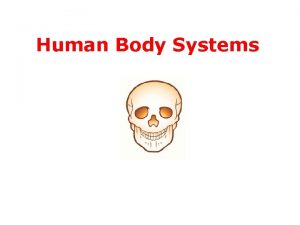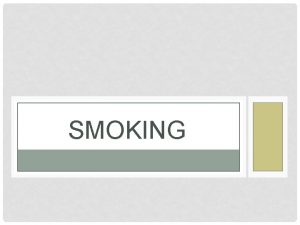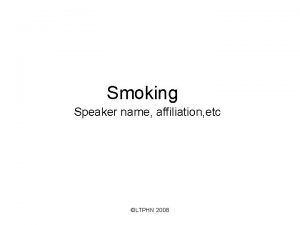Fight Against Smoking From Your Speaker Dr Rhoda













- Slides: 13

Fight Against Smoking From Your Speaker: Dr. Rhoda Yuen Counseling Psychologist 25 th October, 2006

Understanding the Smokers Majority of smokers start at young age. They become addicted by not wanting or failing to quit. Survey indicates that by the age pf 18, most smokers regret having started and half have tried to stop* Henningfield. Tob Control, 2000; Action on Smoking and Health Fact Sheets: Basic Facts 24, 2004

Why become addicted? Besides physical dependence on nicotine, smoking create psychological dependency. People smoke for different reasons: To de-stress, to socialize, for peer acceptance, for an “in or “cool” image.

Differences in the two sexes Male n To control negative feelings like anxiety, depression and nervousness. n Relieve stress and tireness n Social activities n Concentration (e. g: writing、overnight work etc. ) Female n To show character and independency n Emulate male behavior n Want to lose weight

Why do smokers want to quit? Personal reasons: Pregnant/ new birth Death of friends or relative due to smoking-related disease Health problems Financial issues External Smoking ban, non-smoking restaurants etc.

Why fail to quit? Unable to quit abruptly for heavy smokers Withdrawal symptoms (e. g. nervousness, irritable, fatigue) Lack of determination or motivation Lose of confidence after failed atttempts Influenced by friends and environment

Why relapse? Alcohol consumption and social activities Stress Exposure to smoking area Peer pressure Withdrawal symptoms

“NRT - Cut down with Nicorette then stop” Step 1 Build up confidence Tell yourself why you want to quit Know your own triggers (e. g. when you are bored, stressful or with other smokers) Alter your habits (e. g. smoke after meal etc) and find alternatives Learn from own past failed attempts and get workable tips Tell your family about your quitting plan and ask for their support Seek advice from medical professionals (e. g. NRT) Learn how to de-stress and relax Visualize yourself as a non-smoker and believe in your ability to quit

“NRT - Cut down with Nicorette then stop” Step 2 Step by Step Create own plan for quitting To set the quit smoking target and date of completion with medical professionals Make a smoking record De-stress activities (e. g. movie, exercise) Resist the desire of smoking Seek help from personal counseling, quit smoking hotlines or counseling groups Use NRT products (chewing gum, patch or inhaler) according to professional advices

“NRT - Cut down with Nicorette then stop” Step 3 Perseverance Regular review of the progress Continue to reduce the number of cigarette smoked, and use NRT products to relieve the crave for smoking, until the target has been reached Deal withdrawal Avoid triggers and unlink smoking from familiar activities. Find substitute for mouth & fingers Ride out points of craving: (deep breathing, calling friends) consumption of alcohol, have balance diet and adequate sleep Avoid hanging around with other smokers or going to places that smoking is allowed (e. g. Pub) Have a positive and optimistic attitude Reward yourself

A non smoking living environment To establish a smoke free living working environment Tell your colleagues and friends that your office and home are smoke free areas, and to seek their cooperation. Get rid of all the cigarette pack, cigarette case, lighter and ash tray Encourage your family members and friends who smokes to quit. Opt for smoke free dining places and activity venues

To deal with the crave of smoking To deal with the occasional crave for smoking, you may try to: Leave the present situation or to take a break. Divert yourself and let the desire cool down Even if you slip, review what went wrong and renew your commitment Use NRT products when needed

Conclusion Smokers tends to reduce their daily cigarette consumption as a prelude to a serious stop attempt Successful reduction of cigarettes provides “small successes” t o help increase confidence and motivation. Rate of success are higher and relapse rate is lower Gradually cutting down the consumption of cigarette with the help of NRT is more effective in helping smokers to achieve full cessation, as compared with the traditional way (cut down abruptly) of quitting Motivation and confidence are key to achieving successful cessation!
 Bahs jos
Bahs jos Rhoda kellogg etapas del dibujo infantil
Rhoda kellogg etapas del dibujo infantil Piaget rajzfejlődési szakaszok
Piaget rajzfejlődési szakaszok Why did filibusters fight against spanish rule in texas
Why did filibusters fight against spanish rule in texas London 1890 rizal
London 1890 rizal How the nervous system works
How the nervous system works Fight for your family nehemiah
Fight for your family nehemiah Give us your hungry your tired your poor
Give us your hungry your tired your poor 30 pack year smoking history means
30 pack year smoking history means Curious george smoking a pipe
Curious george smoking a pipe Smoking cessation learning objectives
Smoking cessation learning objectives Smoking kills
Smoking kills Pack years in smoking
Pack years in smoking Whats passive smoking
Whats passive smoking

























